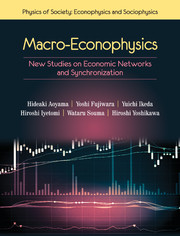Book contents
1 - Introduction: Reconstructing Macroeconomics
Summary
We are no river. But we are not made of clay.
Miroslav PenkovBackground and Motivation
Macroeconomics is aimed at understanding the behavior of the economy as a whole— business cycles, economic growth, employment/unemployment, in ation/de ation, and inequality of income. A macroeconomy, such as that of the U.S. and Japan, consists of more than 100 million consumers and one million firms. Evidently, the behavior of the macroeconomy is the outcome of the aggregation and interactions of a large number of micro units such as consumers and firms. To understand such interactions beneath the surface of the macroeconomy, one must resort to new methods that are different from those of standard microeconomics. We propose that this new method be called Macro-econophysics. It provides one not only with novel theoretical insights but also with new empirical methods. Following the spirit of physics and other natural sciences, macro-econophysics puts equal importance on theory and on empirical findings. This book is concerned with both macroeconomic theory and important findings that advanced the study of macroeconomics.
Macroeconomics was born in the first half of the 20th century. Above all, it was expected to make a good diagnosis of, and hopefully provide a prescription for depression and high unemployment. Keynes’ General Theory of Employment, Interest, and Money, published in 1936, was a landmark work, and had such a profound impact on the discipline that after the war, macroeconomics became synonymous with Keynesian economics (Keynes, 1936). Paul Samuelson once proposed “the neoclassical synthesis,” wherein it is held that the achievement of full employment requires Keynesian intervention but neoclassical theory is valid and useful for efficient resource allocation when full employment is achieved. To many, it was then obvious that the economy occasionally lapses into a recession where labor and other resources are left unemployed. The usefulness of Keynesian economics was taken for granted. Thus, during the 1950s and 1960s, the profession accepted the neoclassical synthesis, and held that economics stood on two pillars, namely, neoclassical microeconomics and Keynesian macroeconomics.
However, Arrow (1967), in his review of the Collected Scientific Papers of Paul Samuelson, pointed out that the neoclassical synthesis was actually nothing but a common sense argument and lacked rigor.
- Type
- Chapter
- Information
- Macro-Econophysics , pp. 1 - 9Publisher: Cambridge University PressPrint publication year: 2017

